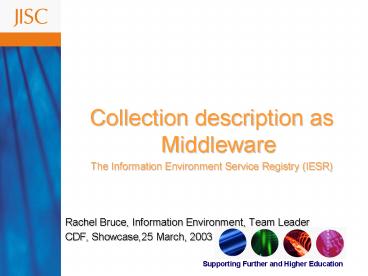Collection description as Middleware - PowerPoint PPT Presentation
Title:
Collection description as Middleware
Description:
Supporting Further and Higher Education. Collection description as Middleware ... Rachel Bruce, Information Environment, Team Leader. CDF, Showcase,25 March, 2003 ... – PowerPoint PPT presentation
Number of Views:14
Avg rating:3.0/5.0
Title: Collection description as Middleware
1
- Collection description as Middleware
- The Information Environment Service Registry
(IESR) - Rachel Bruce, Information Environment, Team
Leader - CDF, Showcase,25 March, 2003
2
Talk overview
- The JISC Information Environment (IE)
middleware/shared services - Information Environment Service Registry (IESR)
pilot - Challenges why
3
What is Middleware
- Middleware, or "glue", is a layer of software
between the network and the applications. This
software provides services such as
identification, authentication, authorization,
directories, and security. In today's Internet,
applications usually have to provide these
services themselves, which leads to competing and
incompatible standards. By promoting
standardization and interoperability, middleware
will make advanced network applications much
easier to use. - Internet2 Middleware Initiative
4
What is the JISC Information Environment?
- to build an on-line information environment
providing secure and convenient access to a
comprehensive collection of scholarly and
educational material - JISC 5-year strategy
5
JISC IE Architecture
- Provides a set of standards protocols that
support the development delivery of integrated
network services allows the user to discover,
access,use and publish digital physical
resources for their learning research
teaching - Andy Powell, UKOLN
6
Current situation-difficult to find
Content (local and remote)
Web
Web
Web
Web
Authentication
Authorisation
End-user needs to join services together manually
- as well as learning multiple user interfaces
End-user
7
Future - easier to find
Content
Authentication
Authorisation
End-user is automatically presented with
relevant resources through relevant channels
Collection Description
Portals
Service Desc.
Thesauri
User Profiles
End-user
8
Shared Services
- What are they? machine readable services between
the presentation layer and the content layer of
the IE (middleware) - User profiling so the right services can be
delivered to the user - Collection description high level description
so portals, VLEs can locate relevant resources - Service description- technical metadata to
allow machines to know if they can interoperate
with services - Other types of high level description- subject,
educational levels, rights high level finding
aids for machines - Authentication authorisation- right user,
access rights - Terminology services-subject, place, help find
the appropriate resource
9
Portals
- What are they?doorways to diverse content
provide cross-searching of distributed and
otherwise discrete resources. - All experimental how well do they address the
discovery mechanism? - User centred discovery for Learning Teaching
- Subject centred humanities, engineering,leisure
and tourism - Format media type - Image
- Building portlet technology plug it in to an
institutional VLE?
10
IESR-pilot
- Service Registry machine readable catalogue of
high-quality resources - MIMAS, Cheshire, UKOLN
- Completes end December 2003
11
- Descriptive metadata- derived from RSLP schema
- Technical metadata- being finalised does a
collection have a Z target, is the associated
metadata available via OAI etc.
12
Descriptions from who?
- Initially
- AHDS, EDINA,Essex Data Archive etc.
- Some publishers
13
Pilot stages
- Consultation with stakeholders
- (Content providers,shared services,end users
etc.) - Development of software
- Development of schema
- Develop Interfaces
- Populate
- Evaluate
14
Challenges
- Keeping it economic and sustainable
- Building, while still designing and researching
- Cultural organisational change
- Granularity of collection
- Integrating the IE with learning environments,
the Research Grid and
15
Why?
- Portal (aggregator) surveys the environment
- Seamless integrated access
- Awareness of collections
- More use
- Improved learning, teaching research
16
Further information
- http//jisc.ac.uk/ie
- http//www.mimas.ac.uk/iesr/
- JISC IE rachel.bruce_at_jisc.ac.uk
- IESR, Project Manager amanda.hill_at_man.ac.uk































